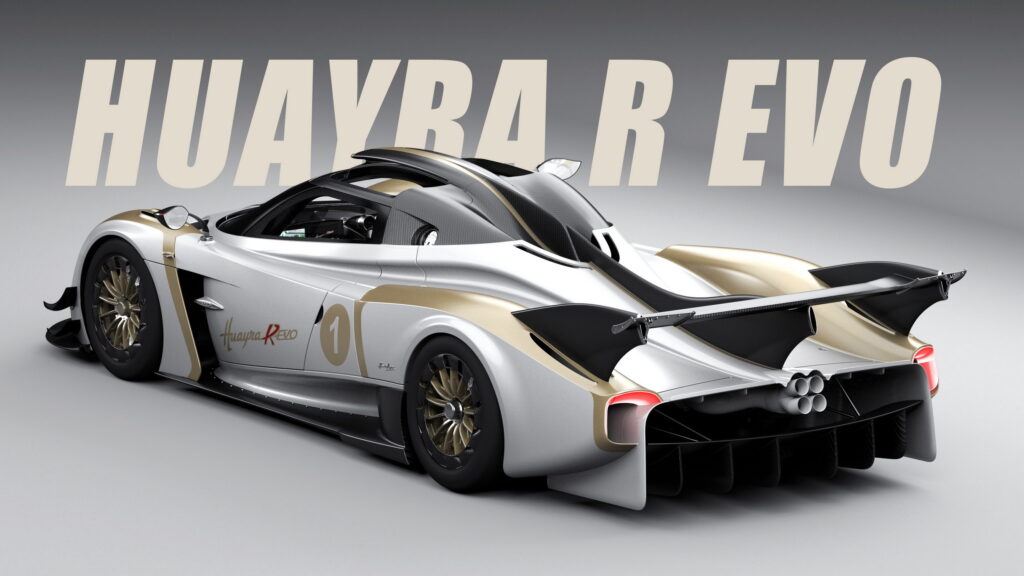A longer tail, removable roof section, better carbon fiber, and an improved V12 contribute to make the Huayra R Evo the most impressive Pagani ever
5 hours ago
 –>
–> 
–>
Horacio Pagani says he was inspired by two types of racecars when he conceived the new long-tailed Huayra R Evo. The idea for creating a new iteration of the car struck him at an IndyCar race, where he was captivated by the aero screens on the open-wheel racers. This sparked the notion of developing an open-top version of his own car. Additionally, Pagani’s nostalgia for the long-tail racecars of his youth played a significant role in his decision to extend the tail of the Huayra R.
The result is a new model with performance close to that of Le Mans’ second-tier prototype racers, which delivers more power, more sound, more downforce, and more performance to the owners who will take part in Pagani’s Arte in Pista program.
Under the hood, the Huayra R Evo retains its 6.0-liter V12 HWA engine, but undergoes a series of enhancements, including a recalibrated ECU, new intake manifold, and camshafts. These upgrades result in an output of 888 hp (662 kW/900 PS) and 568 lb-ft (770 Nm) of torque, marking this as the most powerful Pagani model to date. Furthermore, the V12 can now rev all the way up to 9,200 RPM, sending its power to the rear wheels via a six-speed sequential transmission.
advertisement scroll to continue
Read: This 1 of 10 Pagani Zonda R Evolution Has 800 HP And Just 630 Miles On Its Odometer
The engine is now wrapped in a new long-tail body, which is about 7.5 inches (190 mm) longer than the outgoing Huayra R. It also now has removable panels in the hood, to allow the sound of that raging V12 to reach your ears unimpeded.
Despite the gap in the carbon fiber body work, the car is now 21 percent more aerodynamically efficient. On top of that, the long tail and other modifications result in a 45 percent increase in downforce. In its lowered track mode, the hypercar develops more downforce than it weighs at 199 mph (320 km/h). Since the Huayra R Evo has a dry weight of 2,337 lbs (1,060 kg), that’s a pretty impressive amount of downward pressure.
The design of the body is so ingenious that the car generates the highest level of downforce when the roof panel is removed. Pagani claims that the Huayra R Evo produces 5 percent more downforce in open-top mode compared to closed-top mode.
And that’s not the body’s only new trick. Thanks to cutting-edge carbon fiber technology originally developed for the Utopia, Pagani asserts that the Huayra R Evo is now 38 percent stiffer than its predecessor, despite boasting a lighter overall weight.
Unsurprisingly, the car’s chassis has also been refined with a new heave damper that can raise and lower the car’s ride height without altering the wheels’ dampers. Pagani says that it has also worked on the elasto-kinematics of the Huayra R Evo to improve camber recovery, bump steer correction, and to ensure ideal grip in every scenario.
It says that it has also increased the surface area of the carbon-ceramic front brake discs by 100 percent with a new slot design and larger pads. That has led to increased stability, improved temperature management, and better durability.
Prices for the car have not been revealed (nor have production numbers), but Pagani says that those who purchase participate in the Arte in Pista club will get the chance to drive their cars at some of the world’s top tracks. Included in the package are non-competitive track events, with data analysis, track engineers and mechanics, a motorsports physiotherapist, and a nutritionist.
“The Huayra R and the Arte in Pista program have expanded our clients’ experience with the Pagani brand beyond our wildest dreams, giving a new opportunity to owners of the Zonda R and Zonda Revolución as well,” says Horacio Pagani. “It is our pleasure to share the Huayra R Evo with you, pushing the boundaries of performance and emotion even further. Let’s start by removing the roof and take it from there…”
[embedded content]

